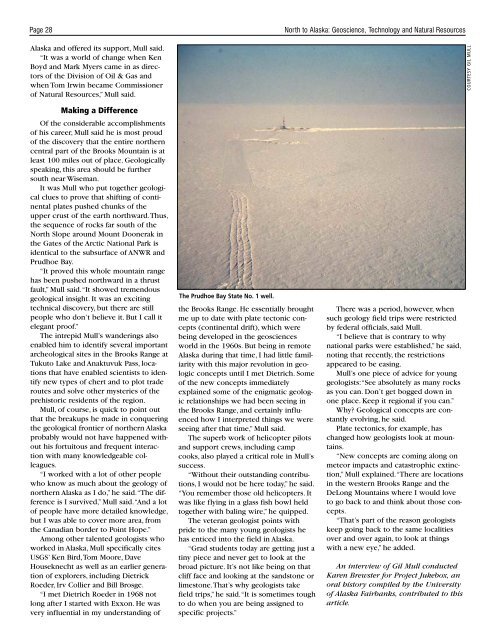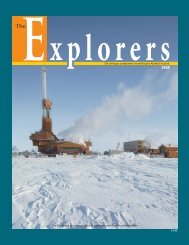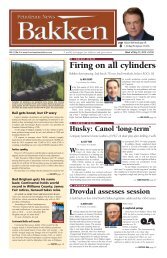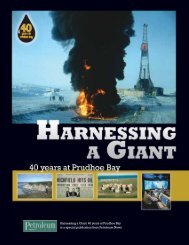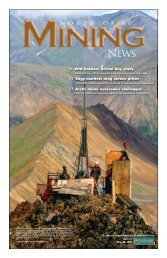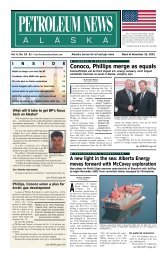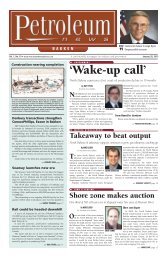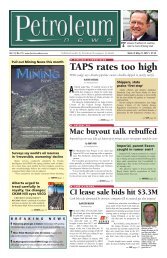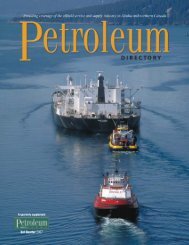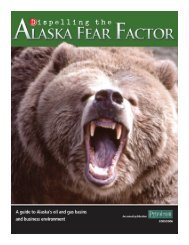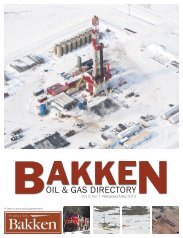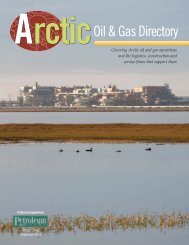North to Alaska - for Petroleum News
North to Alaska - for Petroleum News
North to Alaska - for Petroleum News
You also want an ePaper? Increase the reach of your titles
YUMPU automatically turns print PDFs into web optimized ePapers that Google loves.
Page 28<br />
<strong>Alaska</strong> and offered its support, Mull said.<br />
“It was a world of change when Ken<br />
Boyd and Mark Myers came in as direc<strong>to</strong>rs<br />
of the Division of Oil & Gas and<br />
when Tom Irwin became Commissioner<br />
of Natural Resources,” Mull said.<br />
<strong>North</strong> <strong>to</strong> <strong>Alaska</strong>: Geoscience, Technology and Natural Resources<br />
COURTESY GIL MULL<br />
Making a Difference<br />
Of the considerable accomplishments<br />
of his career, Mull said he is most proud<br />
of the discovery that the entire northern<br />
central part of the Brooks Mountain is at<br />
least 100 miles out of place. Geologically<br />
speaking, this area should be further<br />
south near Wiseman.<br />
It was Mull who put <strong>to</strong>gether geological<br />
clues <strong>to</strong> prove that shifting of continental<br />
plates pushed chunks of the<br />
upper crust of the earth northward.Thus,<br />
the sequence of rocks far south of the<br />
<strong>North</strong> Slope around Mount Doonerak in<br />
the Gates of the Arctic National Park is<br />
identical <strong>to</strong> the subsurface of ANWR and<br />
Prudhoe Bay.<br />
“It proved this whole mountain range<br />
has been pushed northward in a thrust<br />
fault,” Mull said.“It showed tremendous<br />
geological insight. It was an exciting<br />
technical discovery, but there are still<br />
people who don’t believe it. But I call it<br />
elegant proof.”<br />
The intrepid Mull’s wanderings also<br />
enabled him <strong>to</strong> identify several important<br />
archeological sites in the Brooks Range at<br />
Tuku<strong>to</strong> Lake and Anaktuvuk Pass, locations<br />
that have enabled scientists <strong>to</strong> identify<br />
new types of chert and <strong>to</strong> plot trade<br />
routes and solve other mysteries of the<br />
prehis<strong>to</strong>ric residents of the region.<br />
Mull, of course, is quick <strong>to</strong> point out<br />
that the breakups he made in conquering<br />
the geological frontier of northern <strong>Alaska</strong><br />
probably would not have happened without<br />
his <strong>for</strong>tui<strong>to</strong>us and frequent interaction<br />
with many knowledgeable colleagues.<br />
“I worked with a lot of other people<br />
who know as much about the geology of<br />
northern <strong>Alaska</strong> as I do,” he said.“The difference<br />
is I survived,” Mull said.“And a lot<br />
of people have more detailed knowledge,<br />
but I was able <strong>to</strong> cover more area, from<br />
the Canadian border <strong>to</strong> Point Hope.”<br />
Among other talented geologists who<br />
worked in <strong>Alaska</strong>, Mull specifically cites<br />
USGS’ Ken Bird,Tom Moore, Dave<br />
Houseknecht as well as an earlier generation<br />
of explorers, including Dietrick<br />
Roeder, Irv Collier and Bill Brosge.<br />
“I met Dietrich Roeder in 1968 not<br />
long after I started with Exxon. He was<br />
very influential in my understanding of<br />
The Prudhoe Bay State No. 1 well.<br />
the Brooks Range. He essentially brought<br />
me up <strong>to</strong> date with plate tec<strong>to</strong>nic concepts<br />
(continental drift), which were<br />
being developed in the geosciences<br />
world in the 1960s. But being in remote<br />
<strong>Alaska</strong> during that time, I had little familiarity<br />
with this major revolution in geologic<br />
concepts until I met Dietrich. Some<br />
of the new concepts immediately<br />
explained some of the enigmatic geologic<br />
relationships we had been seeing in<br />
the Brooks Range, and certainly influenced<br />
how I interpreted things we were<br />
seeing after that time,” Mull said.<br />
The superb work of helicopter pilots<br />
and support crews, including camp<br />
cooks, also played a critical role in Mull’s<br />
success.<br />
“Without their outstanding contributions,<br />
I would not be here <strong>to</strong>day,” he said.<br />
“You remember those old helicopters. It<br />
was like flying in a glass fish bowl held<br />
<strong>to</strong>gether with baling wire,” he quipped.<br />
The veteran geologist points with<br />
pride <strong>to</strong> the many young geologists he<br />
has enticed in<strong>to</strong> the field in <strong>Alaska</strong>.<br />
“Grad students <strong>to</strong>day are getting just a<br />
tiny piece and never get <strong>to</strong> look at the<br />
broad picture. It’s not like being on that<br />
cliff face and looking at the sands<strong>to</strong>ne or<br />
limes<strong>to</strong>ne.That’s why geologists take<br />
field trips,” he said.“It is sometimes <strong>to</strong>ugh<br />
<strong>to</strong> do when you are being assigned <strong>to</strong><br />
specific projects.”<br />
There was a period, however, when<br />
such geology field trips were restricted<br />
by federal officials, said Mull.<br />
“I believe that is contrary <strong>to</strong> why<br />
national parks were established,” he said,<br />
noting that recently, the restrictions<br />
appeared <strong>to</strong> be easing.<br />
Mull’s one piece of advice <strong>for</strong> young<br />
geologists:“See absolutely as many rocks<br />
as you can. Don’t get bogged down in<br />
one place. Keep it regional if you can.”<br />
Why Geological concepts are constantly<br />
evolving, he said.<br />
Plate tec<strong>to</strong>nics, <strong>for</strong> example, has<br />
changed how geologists look at mountains.<br />
“New concepts are coming along on<br />
meteor impacts and catastrophic extinction,”<br />
Mull explained.“There are locations<br />
in the western Brooks Range and the<br />
DeLong Mountains where I would love<br />
<strong>to</strong> go back <strong>to</strong> and think about those concepts.<br />
“That’s part of the reason geologists<br />
keep going back <strong>to</strong> the same localities<br />
over and over again, <strong>to</strong> look at things<br />
with a new eye,” he added.<br />
An interview of Gil Mull conducted<br />
Karen Brewster <strong>for</strong> Project Jukebox, an<br />
oral his<strong>to</strong>ry compiled by the University<br />
of <strong>Alaska</strong> Fairbanks, contributed <strong>to</strong> this<br />
article.


